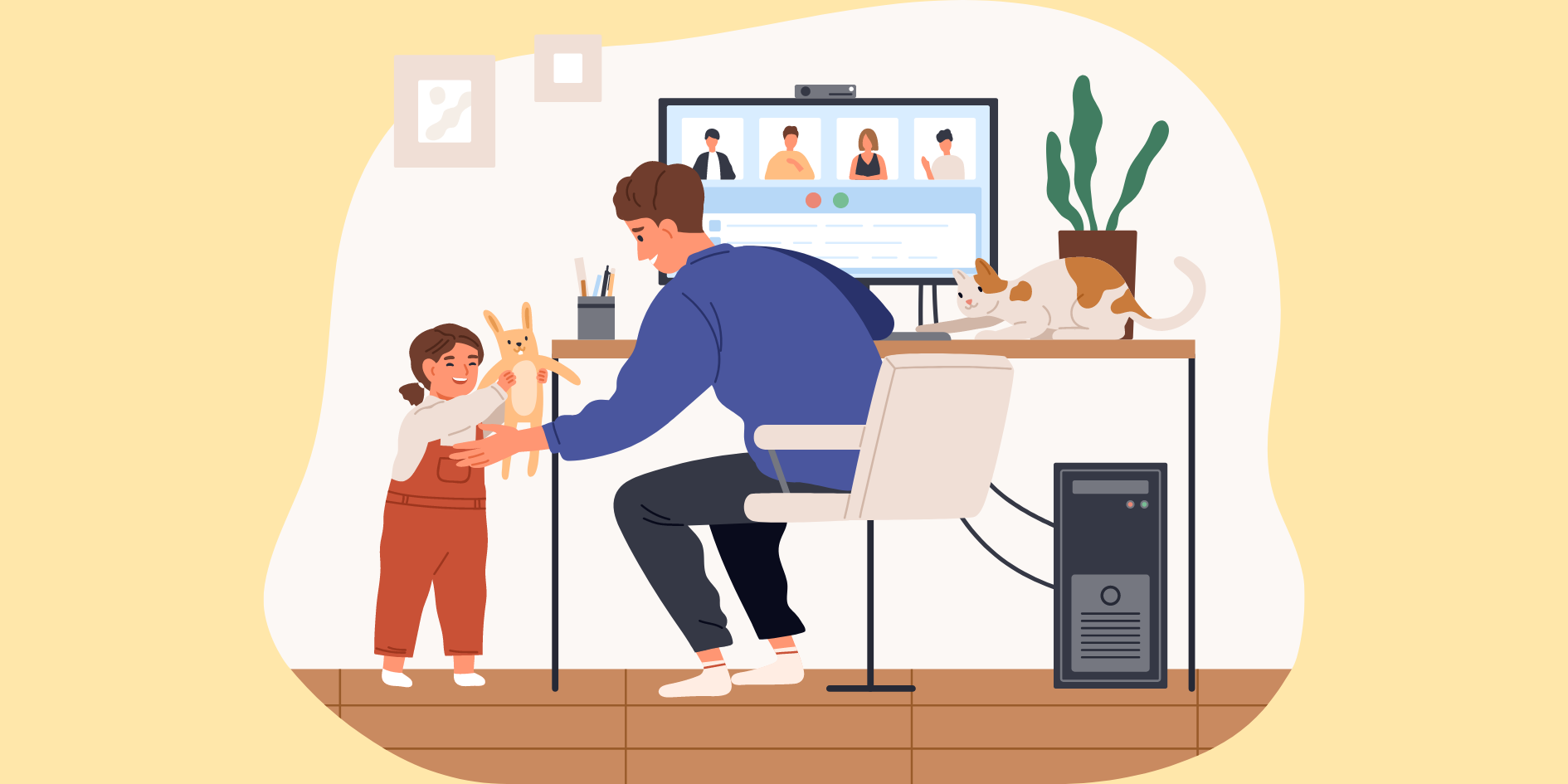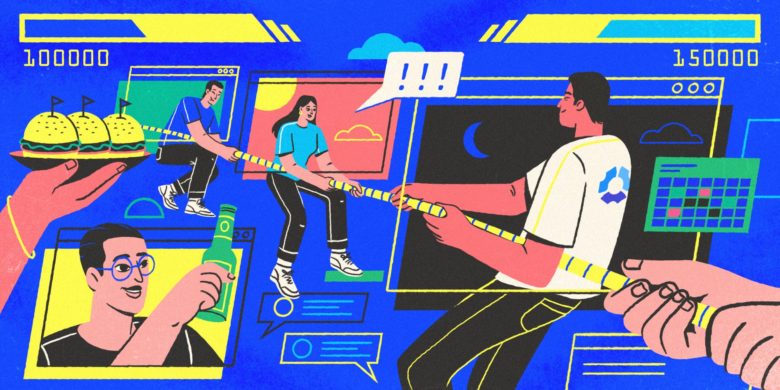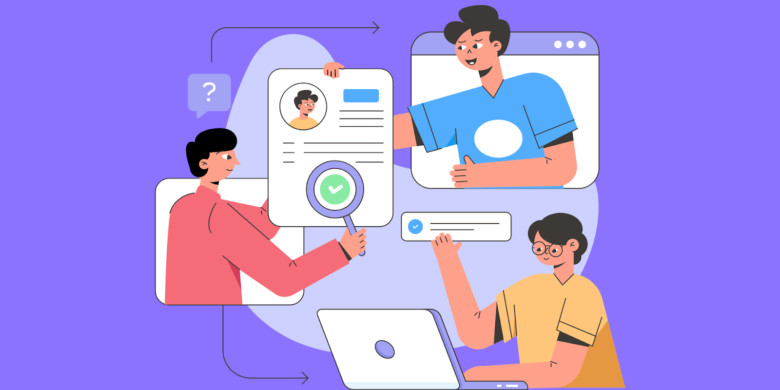As remote workers, we’ve overcome blatant pro-office studies, return-to-office mandates, and a slew of other hurdles. However, even we have to admit that work-from-home distractions genuinely are a threat to remote productivity and the future of this way of working.
Whether it’s pets, kids, or the Roku remote calling to us, our homes are littered with many distractions that remind us of life’s other responsibilities, duties, and desires.
Fortunately, we’re seasoned remote work veterans here at Hubstaff. Long before the pandemic, we’ve embraced the good and bad of remote work to great success. In this post, we’ll share some common distractions, anecdotes from our team’s personal experiences, and solutions to overcome them.
Let’s get started.
Boost your team’s efficiency with Hubstaff's productivity tools
Common work-from-home distractions
If you’re an aspiring remote worker or manager looking to transition your team to remote work, here are some distractions you’ll be signing up for when you leave office life behind:
- Household chores. Chores are not fun — but getting paid to do them makes them a bit more bearable. We’re all guilty of using that time between meetings to take out the trash, catch up on dishes, or vacuum. Resist the urge.
- Hobbies and interests. Maybe you’re into painting, sewing, playing an instrument, or working out. It doesn’t really matter which it is. It’s hard to when those paintbrushes, weights, or drumsticks start staring you down.
- Social media and phone usage. Social media is an issue no matter where we are, with adults spending nearly three hours per day on their phones. That said, it’s easier to justify frequent phone breaks at home where your boss isn’t looking over your shoulder.
- Outages. This one isn’t your fault. When you work from home, you’re susceptible to internet, electricity, and other outages that can damper productivity. The silver lining is remote workers are fully mobile and can always stop by a coffee shop to stay productive. Of course, that presents its own distractions.
- Family, friends, and pets. We love the little ones in our lives, but we all know they leave us pulling our hair out at nearly the same rate as they put a smile on our faces. Whether it’s barking dogs, devious cats, or kids excited to see you after school, balancing work and family is tough.
That last one is a particularly sore subject for some of our Hubstaffers. We love our families, neighbors, and pets, but they can be a distraction. Here are a few anecdotes from our team.
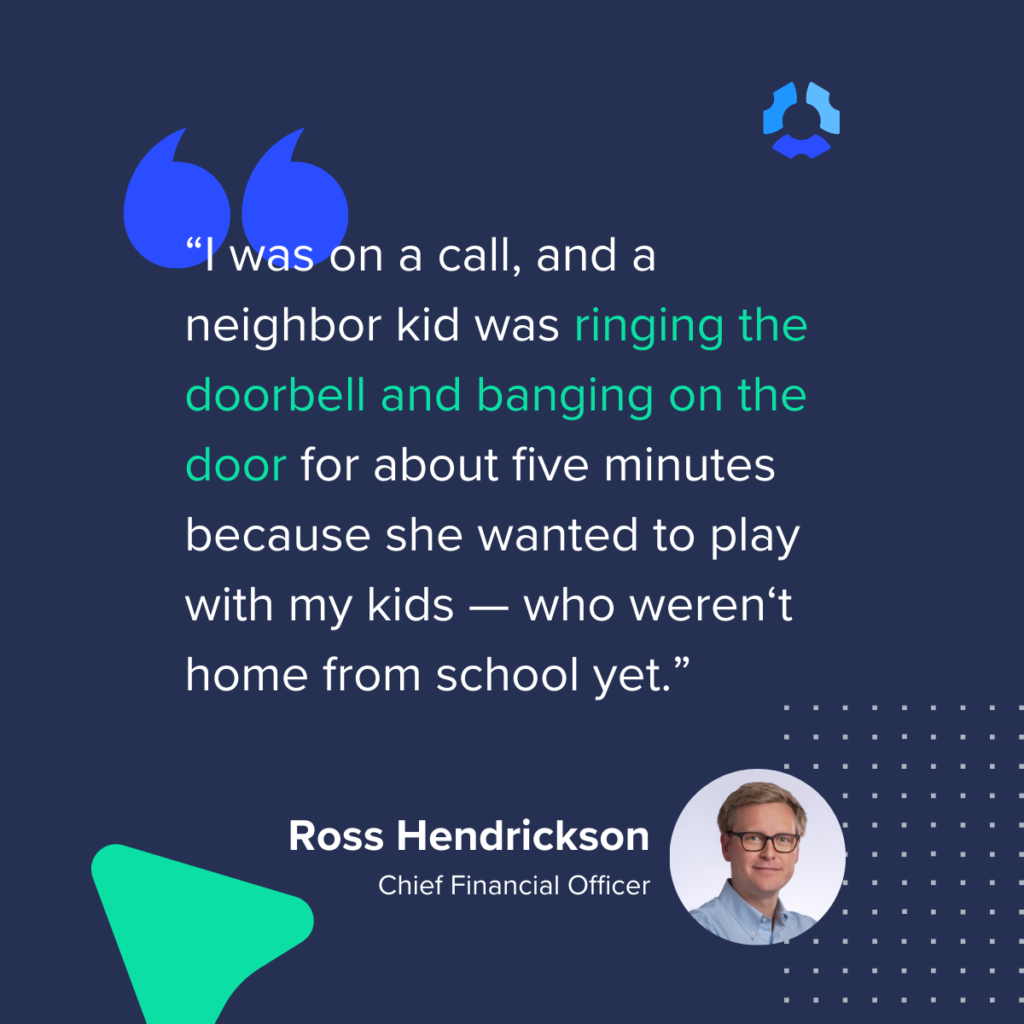
“On the rare occasions where I visit my parents and work from there for a day or two, my 82-year-old grandmother comes down the stairs (knowing full well that I am working at that time) and starts asking me to tend to ‘urgent matters.’ This usually means her TV or laptop needs to be fixed as intended. I’ll often have to be a top grandson and take a break to fix things for her.”
Martin Petrov, EMEA Support Team Lead
Are distractions more prevalent at home?
While family, chores, and hobbies aren’t an arm’s length away at the office, on-site work has its own share of distractions. That begs the question, “Are distractions more prevalent at home?”
Hubstaff’s research data found that remote workers have fewer interruptions each day compared to those in offices. But we don’t want to be too biased, so let’s look at what other research also says.
Like anything else in the remote work debate, there are strong cases for each side. First, let’s look at some stats from Forbes that show the prevalence of distractions at home:
- 80% of remote workers get distracted by kids, partners, pets, and other things that are not an issue when working in an office setting
- 53% of employees feel it’s more difficult to separate work and personal responsibilities when working from home.
- A collection of studies found that remote work brings about a 10-20% reduction in productivity.
While these stats are pretty jarring to see, they only show half the story. Contrary to the beliefs of those championing return-to-office mandates, in-office work has plenty of distractions, too.
Let’s take a look at how employees feel about distractions in the workplace.
Are distractions more prevalent in the office?
We’ve discussed many of the work-from-home distractions, but what about in-office distractions? A CareerBuilder study shows plenty of distractions to be concerned about in an office setting as well.
Of all in-office workers surveyed, they cite the most popular distractions as:
- Cellphones and texting – 55%
- Internet usage – 41%
- Office gossip – 39%
- Social media – 37%
- Co-workers dropping by – 27%
- Smoke or snack breaks – 27%
- Email – 26%
- Meetings – 24%
- Background noise from co-workers – 20%
- Sitting in a cubicle – 9%
Some of those distractions are unavoidable in remote work environments.
That said, office gossip and noisy spaces do account for a considerable amount of distractions. A more general exploration of workplace distractions from companies like Zipdo and Nextiva shows that in-office work is viewed as generally more distracting than remote work:
- 63% of employees feel distracted by their office environment. (Zipdo)
- 80% of employees believe that working remotely reduces workplace distractions. (Zipdo)
- 67% of remote employees feel a better work-life balance (and therefore can better minimize distractions) when working from home. (Nextiva/PwC)
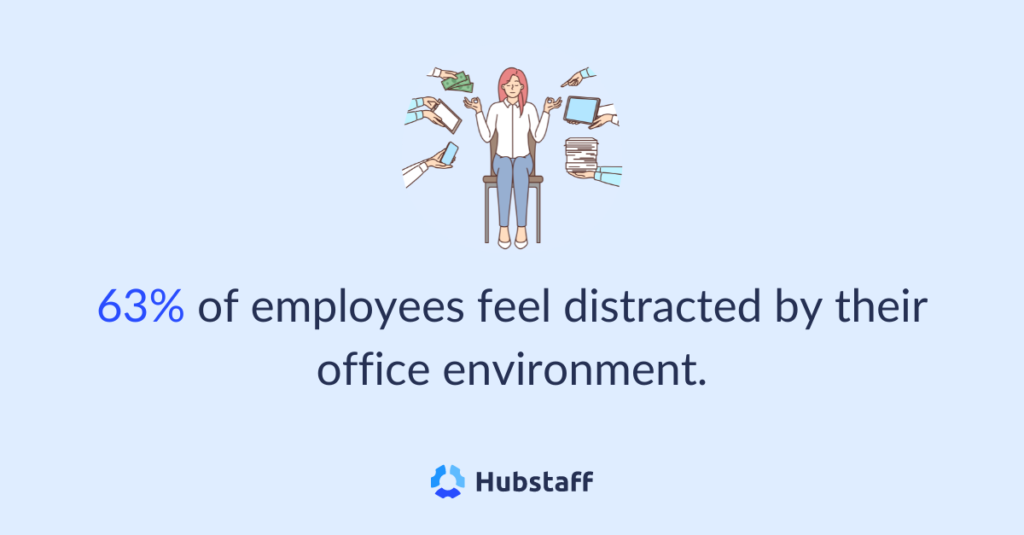
Now that you’re validated by seeing the less-talked-about distractions of office work, it’s time to circle back to some strategies to avoid distractions when working from home.
Strategies to avoid distractions
Just like with in-office work, the perils of working from home will always be there — but that doesn’t mean you can’t do anything about it. Some distractions can be limited, while you may be able to avoid others altogether. Let’s take a closer look.

How to avoid distractions while working from home
To avoid some of the everyday distractions of the remote work lifestyle, there are many things you can do like:
- Turn off notifications. Believe it or not, your phone has an off switch — or at least a do-not-disturb mode. If you’re not sure how to do it, there are countless support pages for iPhone, Slack, and any other device or tool you can imagine.
- Relocate. If you can’t avoid distractions at home, relocate to somewhere less distracting. Remote work and work-from-home don’t have to be synonymous. The greatest advantage over in-office work is the ability to pick up and move to a library, coffee shop, or even another room to cut out distractions.
- Use employee productivity software. Similar to do-not-disturb modes, some tools allow you to set productive and unproductive apps, block certain websites, and tweak idle timeout settings to stop payments when employees walk away from their computers for too long.
How to limit distractions when you’re working
Cutting out distractions entirely is a bit optimistic.
If you can’t eliminate them, you can at least utilize some strategies to limit them, like:
- Create a dedicated workspace. It’s hard to separate work and personal life when working from home. Set up a home office (or at least a workstation) and try to remove common distractions from the space.
- Set goals. There are plenty of KPIs, OKRs, and other goals we’re expected to meet at work — but don’t sleep on personal goals. Setting short-term goals is an excellent way to stay productive and put some necessary pressure on yourself to stay focused.
- Take frequent breaks. Sometimes, you’ll be less distracted if you just take a break. Take the dog for a walk so she stops barking. Take 20 minutes to greet your kids when they come home from school. Go for a quick run to resist the urge to do a full workout. Breaks can actually increase your productivity when you return to work recharged.
- Use time management techniques. The remote work trend didn’t invent inefficiency. There have been productivity methods like the Pomodoro technique, Getting Things Done, and Eat the Frog popping up for ages. Find your favorite and master it.
- Work your most productive hours. If you are in a position where you can create your own working hours or push for asynchronous scheduling at your company, it’s worth considering. If you can move hours earlier or later to reach peak productivity, it’s often worth the effort.
Wrapping up work-from-home distractions
With return-to-office mandates and studies attempting to prove that we need a massive return-to-office movement, it’s easy to double down on championing remote productivity studies and denying any potential distractions.
However, if you’re a remote employee looking to combat return-to-work policies or a manager trying to justify remote or hybrid work, being vocal about the positives and negatives of remote work is key. As we also learned, the lack of a private life makes in-office work distracting, too.
With these statistics and strategies at your disposal, create an open dialog with your team, boss, or anyone else involved in your decision to work remotely. With the right tools, you can make any work situation feasible.
Most popular
The Fundamentals of Employee Goal Setting
Employee goal setting is crucial for reaching broader business goals, but a lot of us struggle to know where to start. American...
Data-Driven Productivity with Hubstaff Insights: Webinar Recap
In our recent webinar, the product team provided a deep overview of the Hubstaff Insights add-on, a powerful productivity measurem...
The Critical Role of Employee Monitoring and Workplace Security
Why do we need employee monitoring and workplace security? Companies had to adapt fast when the world shifted to remote work...
15 Ways to Use AI in the Workforce
Whether through AI-powered project management, strategic planning, or simply automating simple admin work, we’ve seen a dramatic...
